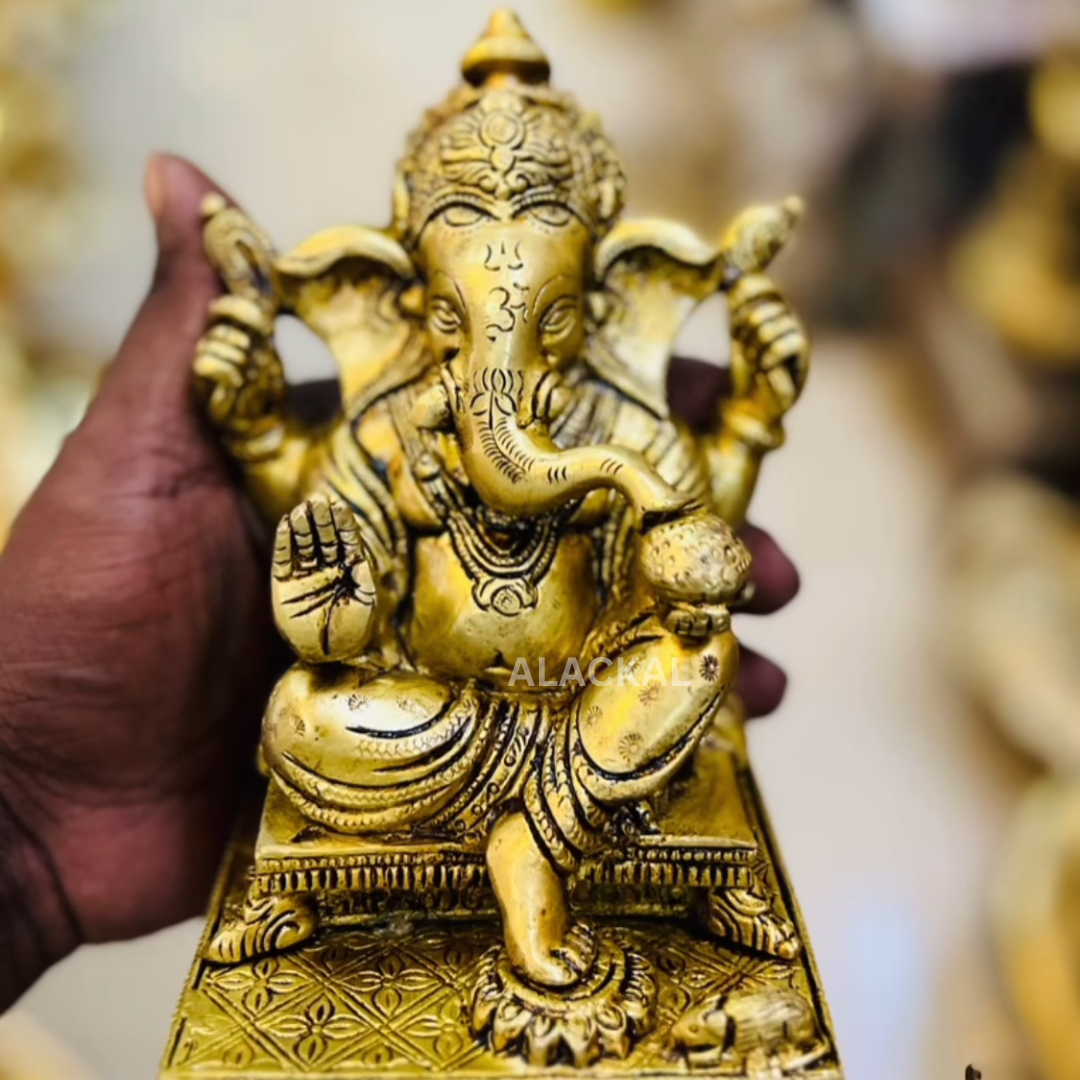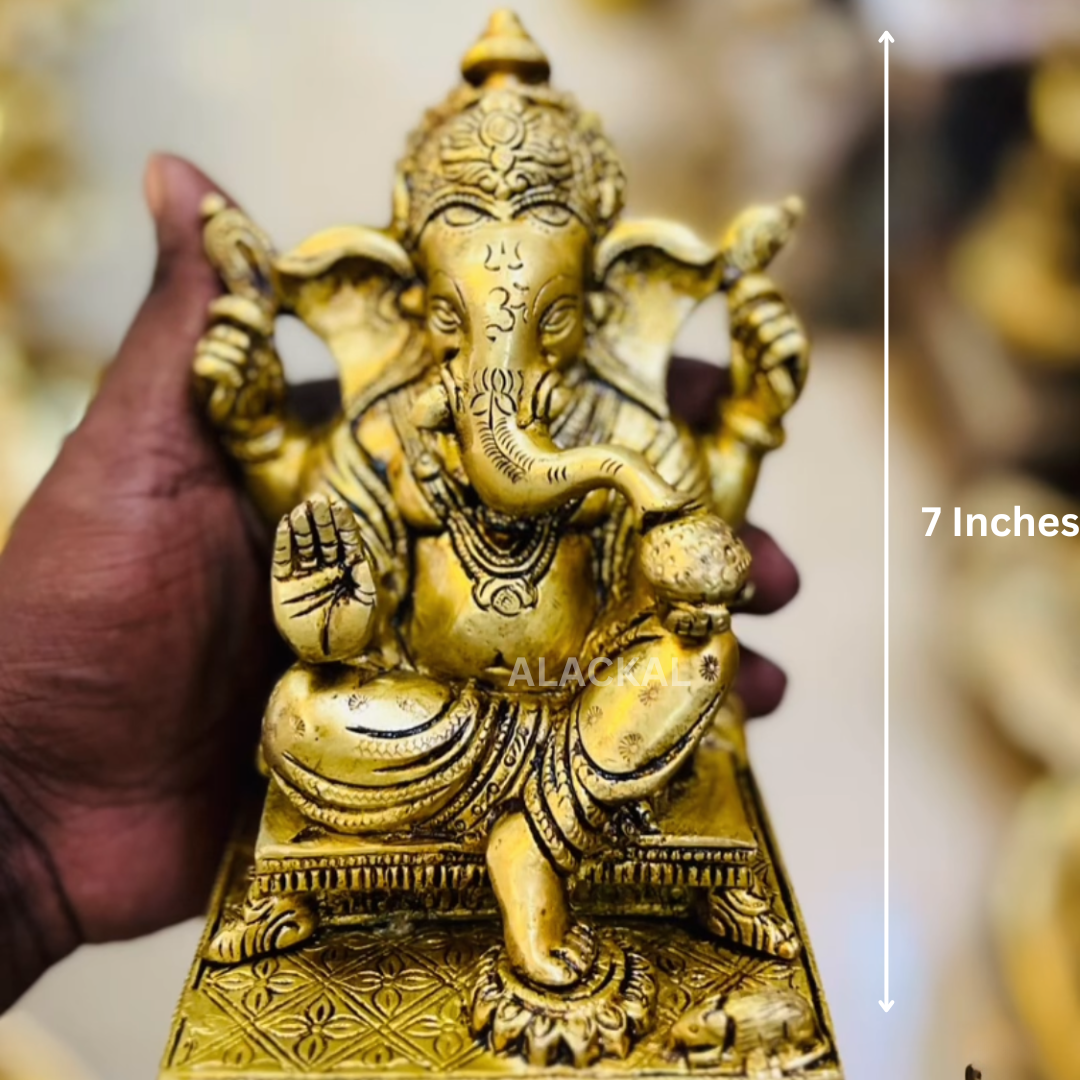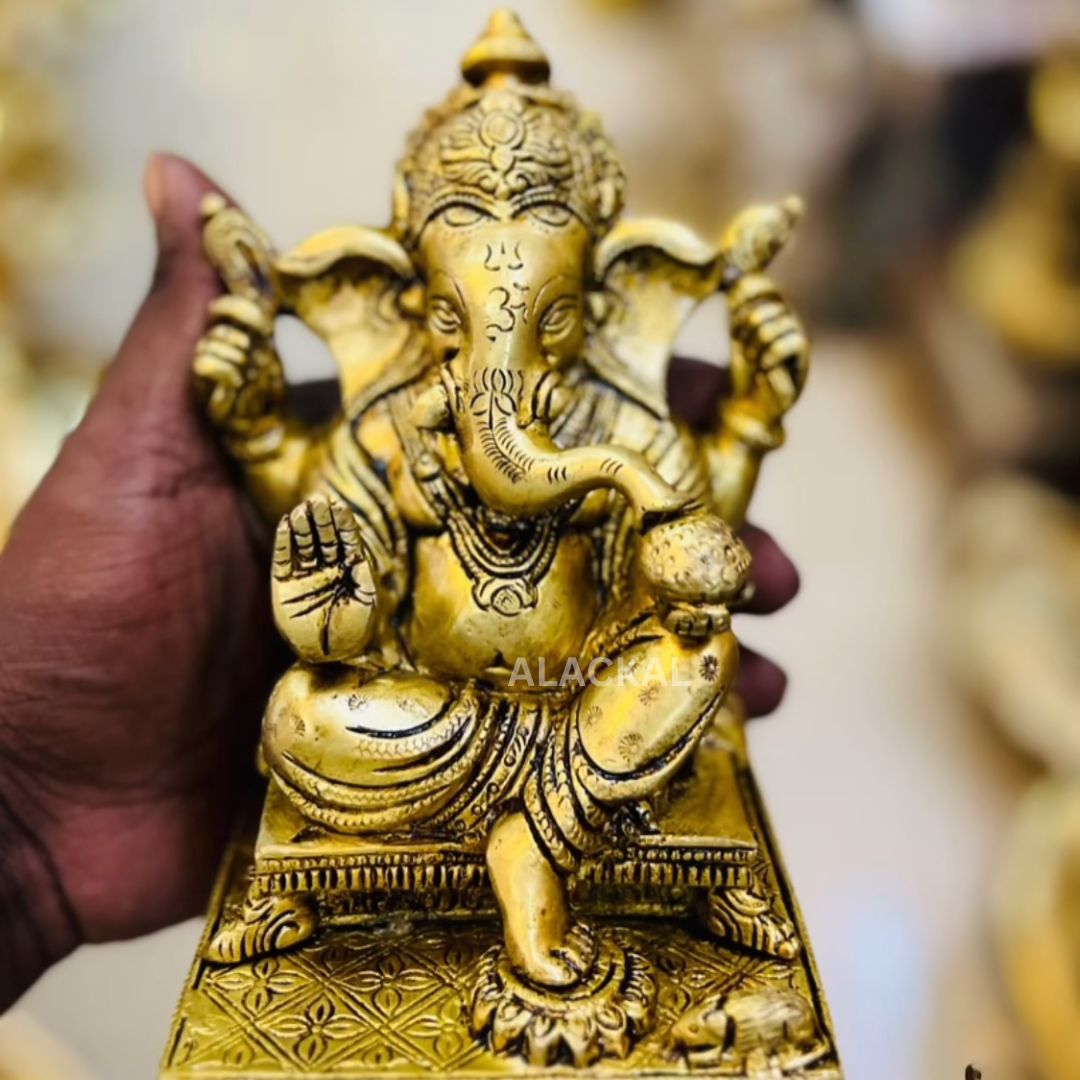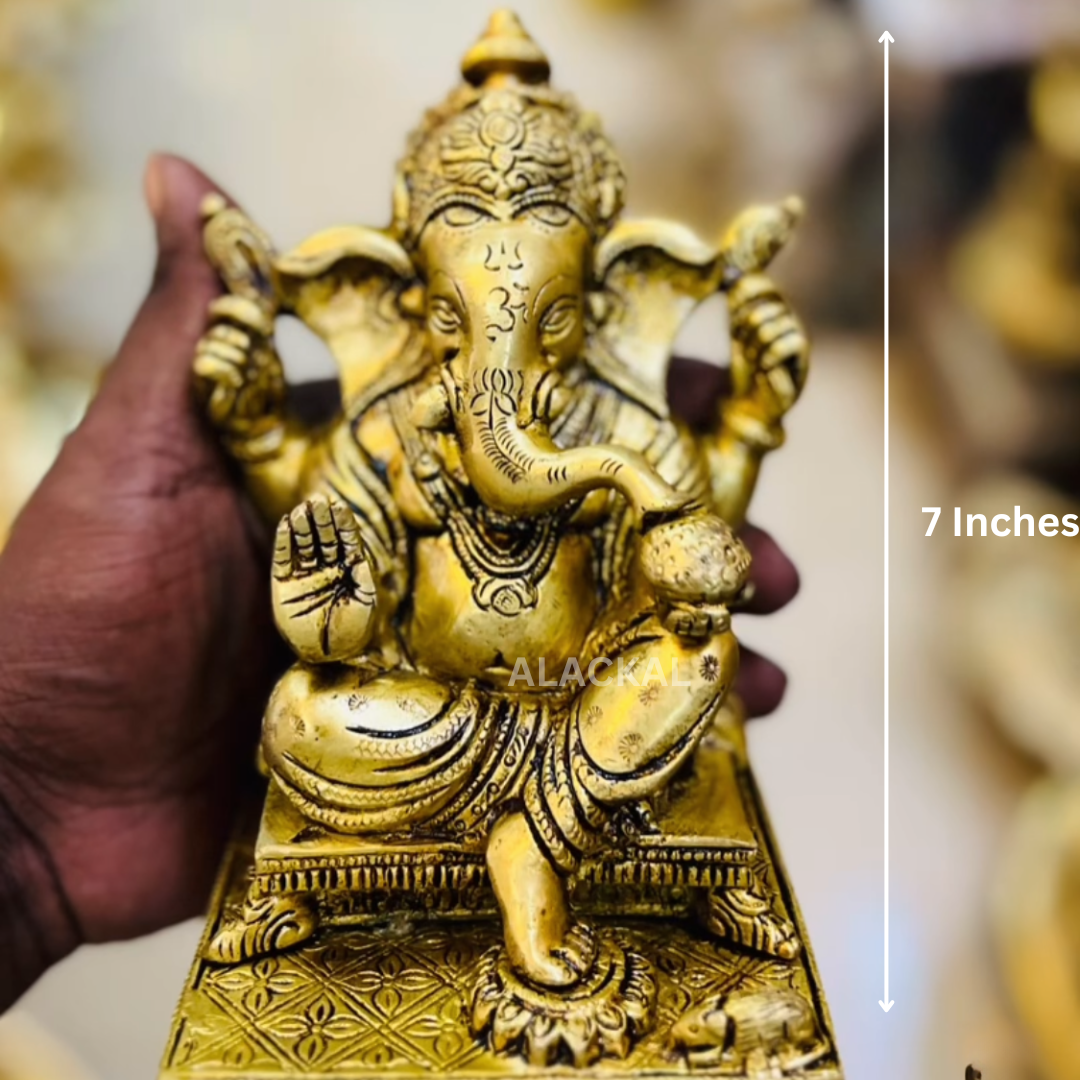Alackal Bell Metals
BRASS GANESHA IDOL | GANAPATHY VIGRAHAM | LEFT TRUNK VINAYAKA | GANESHOLSAVAM | VINAYAKACHATHURTHI
BRASS GANESHA IDOL | GANAPATHY VIGRAHAM | LEFT TRUNK VINAYAKA | GANESHOLSAVAM | VINAYAKACHATHURTHI
Couldn't load pickup availability
Ganesha, also known as Vinayaka, is one of the most beloved and revered deities in Hinduism. His image transcends religious boundaries and is widely recognized as the harbinger of good fortune, wisdom, and prosperity. Every year, millions of devotees celebrate Ganesha Chaturthi, a grand festival honoring Lord Ganesha. Among the many idols available for this auspicious occasion, the brass Ganesha idol with peedom from Alackal Bell Metals, Mannar, is particularly special. This blog will explore the cultural and spiritual significance of the Brass Ganesha Vigraham with the left trunk, its importance during Ganesha Chaturthi, and why Alackal Bell Metals, Mannar, is the ideal place to source this exquisite idol.
Significance of Ganesha in Hindu Tradition
Ganesha is known as the remover of obstacles and the god of beginnings. His blessings are invoked before starting any new venture, be it a marriage, business, or even an academic pursuit. Lord Ganesha's figure is symbolic and richly laden with meanings:
- Elephant head: Denotes wisdom, strength, and discerning intelligence.
- Large ears: Symbolize an attentive and open mind, ever willing to listen.
- Small eyes and trunk: Represent sharp focus and the ability to adapt and overcome challenges.
- Large belly: Denotes the ability to digest all experiences—good and bad.
- Multiple arms holding various items: Each object in his hand signifies different virtues such as wisdom (book), prosperity (modak), and protection (axe).
Each Ganesha idol holds deep symbolic value, but the left trunk Ganesha, which is the focus of this blog, is particularly significant during the festival of Ganesha Chaturthi.
Left Trunk Ganesha: Its Importance and Symbolism
In Hindu tradition, Ganesha idols are often categorized based on the direction of the trunk. There are two primary types: right trunk Ganesha and left trunk Ganesha. For this blog, we focus on the left trunk Ganesha, as the brass Ganapathy Vigraham from Alackal Bell Metals, Mannar, features this specific design.
-
Left Trunk Ganesha is considered more auspicious and calming. It is believed to represent Ida Nadi, the energy channel associated with the moon. This brings a sense of peace, relaxation, and balance to the worshippers. A left trunk Ganesha is generally worshipped in homes for prosperity, harmony, and overall well-being.
-
Right Trunk Ganesha, on the other hand, represents Pingala Nadi, associated with the sun and is worshipped with more strict rituals. It is considered more fierce and powerful but requires precise and disciplined worship.
Given that Ganesha Chaturthi is a time for celebrating beginnings and invoking blessings for peace and prosperity, left trunk Ganesha idols are most commonly chosen by devotees for home altars, pooja rooms, and festive celebrations. The calm energy radiated by this form of Ganesha makes it ideal for daily worship and special occasions alike.
Ganesha Chaturthi and the Role of the Brass Ganesha Idol
Ganesha Chaturthi, also known as Vinayaka Chaturthi, is a festival celebrating the birth of Lord Ganesha. The celebration lasts for 10 days, starting with the installation of Ganesha idols on the first day and ending with the Visarjan, where the idols are immersed in water as a symbolic return to the elements.
One of the most important aspects of this festival is the installation of the Ganesha idol, known as Prathishta. For this sacred act, choosing the right idol is crucial. Traditionally, clay idols were used, but over time, materials like brass have become popular due to their durability, beauty, and spiritual significance.
Here’s why the Brass Ganesha Idol with Peedom from Alackal Bell Metals, Mannar is ideal for Ganesha Chaturthi:
-
Durability: Unlike clay idols, which are meant for temporary use and then immersed, brass idols are permanent. They can be used every year for the festival and for regular worship in the pooja room.
-
Spiritual Significance: Brass is considered a pure metal in Hindu tradition, and idols made from it are believed to radiate positive energy. The Brass Ganesha Vigraham holds immense spiritual potency, making it ideal for invoking the blessings of Lord Ganesha.
-
Artistic Detailing: The brass Ganesha idol from Alackal Bell Metals is not just an object of worship but a work of art. The intricate craftsmanship, detailed carvings, and the carefully designed peedom (base) ensure that the idol stands as a centerpiece of reverence and aesthetics during the festival.
Brass Ganesha Idol with Peedom: A Masterpiece from Alackal Bell Metals, Mannar
Alackal Bell Metals, Mannar, located in the heart of Kerala’s brassware hub, is renowned for creating handcrafted metal idols that honor tradition and fine craftsmanship. This brass Ganesha idol with peedom is no exception.
-
Handcrafted by Artisans: Each brass Ganesha idol is handcrafted by skilled artisans who have honed their craft over generations. The result is an exquisitely detailed piece that combines artistic expression with religious devotion.
-
Perfect for Pooja Rooms and Homes: The peedom serves as the base of the idol and elevates its stature, giving the Ganesha Vigraham a grand yet approachable presence. The peedom design adds to the aesthetic beauty and stability of the idol, making it a suitable addition to home pooja rooms and spiritual spaces.
-
Eco-Friendly and Long-Lasting: Unlike the clay idols, which disintegrate after Visarjan, brass idols last for years and require minimal maintenance. Brass is also a recyclable metal, making this a sustainable choice for eco-conscious devotees.
-
Ethically Made: Alackal Bell Metals takes pride in its commitment to ethical practices, ensuring that each idol is crafted in a way that honors both tradition and sustainability.
Auspicious Features of the Ganesha Idol from Alackal Bell Metals
-
Elegant Design: The brass Ganesha idol showcases Ganesha seated majestically with his trunk turned to the left, a symbol of wisdom, happiness, and prosperity. The design also incorporates intricate carvings that highlight Ganesha’s serene and benevolent demeanor.
-
Ornate Peedom: The peedom, or pedestal, is not just a functional base but also a beautifully carved piece in itself. It adds a regal touch to the overall appearance of the idol and ensures that the deity is raised to a height that commands attention and respect.
-
Symbolism in Posture: The posture of the Ganesha idol, with one foot resting on the ground and the other raised on the peedom, symbolizes the importance of being grounded in reality while aspiring to spiritual growth.
-
Precision Craftsmanship: Alackal Bell Metals is known for its precise attention to detail, and this idol is no exception. The delicate features of Ganesha’s face, the fine detailing on his ornaments, and the smooth, polished finish of the brass make this idol a visual masterpiece.
How to Worship Left Trunk Ganesha During Ganesha Chaturthi
-
Preparation: Cleanse the pooja area and adorn it with fresh flowers, lights, and rangoli. The Brass Ganesha Vigraham from Alackal Bell Metals should be placed on a clean, decorated surface, ideally on the peedom.
-
Offering and Rituals: Begin with a prayer invoking Lord Ganesha’s blessings. Offer items like modak, fruits, flowers, and coconut, which are Ganesha’s favorite. Brass is known for absorbing and radiating spiritual energy, so using a brass idol enhances the spiritual connection during prayers.
-
Chanting: Chant mantras like “Om Gan Ganapataye Namah” and recite Ganesha Stotras to invoke the deity’s blessings for prosperity and success.
-
Daily Pooja: While Ganesha Chaturthi may be a specific festival, worshipping Ganesha is a daily practice for many devotees. The Brass Ganesha with Peedom makes for a perfect permanent fixture in your pooja room for regular worship throughout the year.
Why Choose Alackal Bell Metals, Mannar?
Alackal Bell Metals, located in the historic town of Mannar, Kerala, is a trusted name in the world of brassware. Known for its handcrafted metal items, particularly religious idols, Alackal Bell Metals offers a wide range of traditional brass artifacts that are both aesthetically beautiful and spiritually significant.
Here are a few reasons why Alackal Bell Metals is the best choice for sourcing your brass Ganesha idol:
-
Heritage Craftsmanship: Mannar has a rich history of brass-making, and Alackal Bell Metals has continued this tradition by working with local artisans who have inherited these skills from previous generations.
-
Customization Options: You can choose from a variety of designs, sizes, and finishes, ensuring that the Ganesha idol meets your specific needs and aesthetic preferences.
-
High-Quality Brass: Alackal Bell Metals uses only the highest quality brass to ensure that each idol is not only beautiful but also durable.
-
Wide Range of Religious Artifacts: From brass oil lamps to pooja thalis, Alackal Bell Metals offers a complete range of items to create a fully equipped and beautiful pooja room.
Conclusion
The Brass Ganesha Idol with Peedom from Alackal Bell Metals, Mannar, is more than just a religious artifact—it is a symbol of tradition, spirituality, and exquisite craftsmanship. Whether you are looking for an idol to worship during Ganesha Chaturthi or a timeless addition to your pooja room, this handcrafted Ganesha Vigraham with a left trunk is the perfect choice. The intricate details, spiritual significance, and high-quality craftsmanship make it a piece that will not only bring blessings into your home but also serve as a beautiful work of art that can be cherished for generations.
By choosing Alackal Bell Metals, you are not only investing in a meaningful religious artifact but also supporting the rich heritage of traditional Indian brass craftsmanship.
Share




